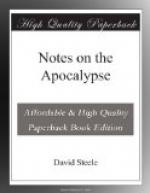6. And I saw the woman drunken with the blood of the saints, and with the blood of the martyrs of Jesus: and when I saw her, I wondered with great admiration.
V. 6.—This “woman,”—Christian church,—was “drunken with the blood of saints and martyrs.” Of course, such a sight would give rise to the apostle’s astonishment. The attempt of popish writers to apply this to pagan Rome’s persecutions is demonstrably false; for John could not “wonder” at the persecution of the church when he was himself an actual victim in Patmos, (ch. i. 9.)
7. And the angel said unto me, Wherefore didst thou marvel? I will tell thee the mystery of the woman, and of the beast that carrieth her, which hath the seven heads and ten horns.
8. The beast that thou sawest, was, and is not; and shall ascend out of the bottomless pit, and go into perdition: and they that dwell on the earth shall wonder (whose names were not written in the book of life from the foundation of the world,) when they behold the beast that was, and is not, and yet is.
9. And here is the mind which hath wisdom. The seven heads are seven mountains, on which the woman sitteth.
10. And there are seven kings: five have fallen, and one is, and the other is not yet come; and when he cometh, he must continue a short space.
11. And the beast that was, and is not, even he is the eighth, and is of the seven, and goeth into perdition.
Vs. 7-11.—The angel explains the “mystery of the woman and of the beast that carrieth her.” The beast, the civil power, carrieth, sustains the woman, the church; as the church controls the state, (v. 3; ch. xiii. 1, 11, 16.) The “beast that was, and is not, and yet is,” is a mysterious personage as well as the woman; therefore all who “dwell upon the earth,”—not in “heaven, wonder,” (ch. xiii. 3-6;)—that is, all the vassals of Antichrist, distinguished from those whose “names are in the book of life,”—the two witnesses.—“The seven heads” of the beast signify seven mountains, on which Rome literally stands, namely, Capitoline, Palatine, Aventine, Esquiline, Coelian, Viminal and Quirinal. Here the woman and Rome are manifestly identical,—the spiritual empire. But the heads of the beast have a double meaning; for they also signify “seven




